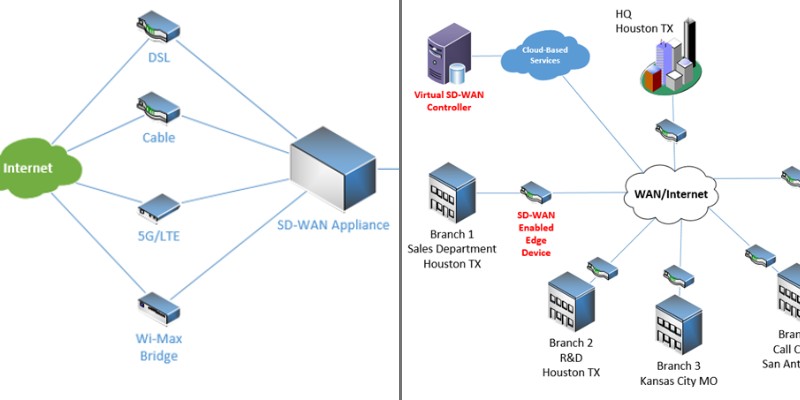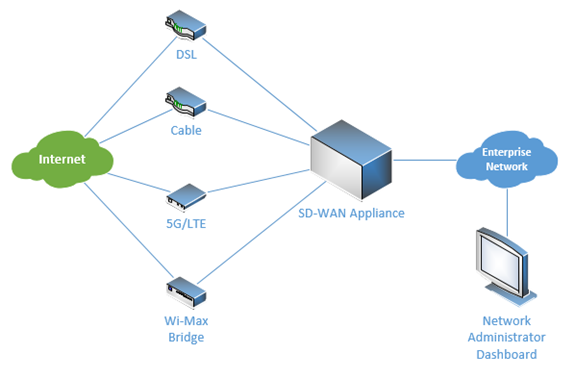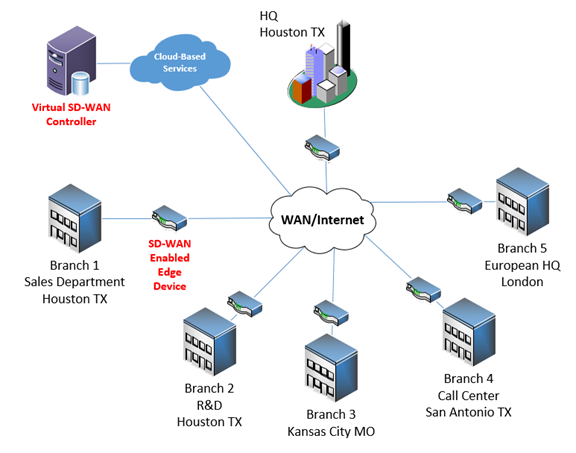A Software Defined Wide Area Network (SD-WAN) is a concept that has been around for over a decade. SD-WAN is a WAN architecture that uses software-defined network technology to deliver a high availability, low cost, and highly flexible WAN connections over the Internet and other public networks.

In this article, we will attempt to shed light upon SD-WAN and what it is, as well as some of the advantages and disadvantages of this technology.
What is SD-WAN?
SD-WAN is a subset of Software Defined Networking (SDN), a network design approach that enables you to design and manage a network, which is composed of dozens or hundreds of network devices, in a centralized manner.
SD-WAN specifically deals with the network edge, that is, the portion of the network that interconnects with the outside world.
This can include interconnections with private WANs for multi-site organizations, as well as public networks such as the PSTN, Cellular network and the Internet.
SD-WAN uses a centralized controller from which all WAN connections and related WAN devices can be managed simultaneously, whether they exist at a single physical location, or within a framework of a multi-site enterprise.
Practically speaking, this means that all WAN connections can be managed from a single controller or dashboard.
This is extremely helpful because it allows for a more consolidated management of such connections as well as a massively improved streamlining of operations.
SD-WAN on a single edge network
One common implementation scenario of SD-WAN is the use of multiple commercial grade connections in conjunction to achieve a higher quality, more resilient WAN connection. Examine the following diagram:

In this case, an enterprise is using an SD-WAN appliance, which may be a physical device or a cloud-based entity, to load balance and dynamically route traffic over four different commercial grade WAN connections.
The appliance is able to employ redundancy, quality of service, high availability, and load balancing in a dynamic way, resulting in a much higher quality WAN link than any of the individual technologies used alone.
SD-WAN in a multi-site environment
A more sophisticated and involved application of SD-WAN involves the interconnection of multiple remote sites of a corporation over the Internet using one or more WAN links at each remote location. Examine the following diagram:

Each of those WAN links is managed by an SD-WAN enabled edge device which is controlled centrally from the virtual SD-WAN controller.
The controller can dynamically create VPN links between branches as needed depending upon various factors including traffic, congestion, applications being used, and time of day, to name a few.
Cisco’s SD-WAN solution
In 2017, Cisco acquired Viptela Inc., an SD-WAN company, and incorporated Viptela’s SD-WAN solution into its own portfolio of services.
Cisco’s SD-WAN solution incorporates a comprehensive cloud-based scalable architecture that can be deployed either on physical devices or within a virtualized network. Cisco’s solution uses the following components:
- vManage – the centralized network management system used to configure and manage the entire SD-WAN solution
- vSmart – the control plane of the architecture used to advertise routes, security, and policy information
- vBond – the orchestrator used to authentication vSmart controllers and vEdge routers
- vEdge – the software or hardware routers at each remote site responsible for the data plane
There are other available solutions on the market as well, but all conform to the general guidelines of an SD-WAN solution.
Advantages of SD-WAN
There are a multitude of benefits to SD-WAN. Some are more obvious while others are a little harder to grasp. These include:
- Simplified management – With an SD-WAN controller, network administrators are able to control all WAN connections as a single entity. SD-WAN controllers provide a high-level configuration environment where general parameters can be defined. The controller is then smart enough to send the appropriate commands to the appropriate network devices to achieve the desired results. What in the past would have taken several days of designing, and several hours of implementation, today can be achieved with several clicks on an SD-WAN dashboard.
- Improved security – SD-WAN controllers are able to employ multiple layers of security on their managed WAN connections, even if the managed WAN connections don’t inherently deliver high security.
- Consolidation of multiple WAN connections – SD-WAN is capable of consolidating multiple types of WAN connections, resulting in an increase in efficiency, resiliency, and quality of service compared to the use of any one of those technologies alone. This results in
- A decrease in cost
- An increase in throughput
- Dynamic traffic engineering based on continuously changing traffic patterns and parameters
- An increase in redundancy and availability
- Application optimization – SD-WAN technology can improve application delivery using caching. This results in the local storing of recently accessed information in memory to speed up future access. This is especially useful in cloud-based application delivery.
Disadvantages of SD-WAN
Now having lauded the wonders of SD-WAN, the question remains, are there downsides to SD-WAN? Well, yes, as with everything, there are.
- Increased Complexity – Arguably the most apparent is the level of complexity that you add to your network. In order to make SD-WAN work correctly, safely, and securely, you need to ensure:
- Your (non-trivial) SD-WAN setup is correctly implemented
- Your QoS and security policies are correctly applied
- Changes made to infrastructure must take into account the SD-WAN configuration.
- New Skillset required – Compared to a simple fiber WAN connection, or a wireless link, this requires a whole new skillset for your ICT team, which may mean cheaper costs for infrastructure, but higher costs for training, retraining, and obtaining the appropriate competences on your team.
- No Quality of Service on Internet Connections – There is another disadvantage of SD-WAN that must be addressed, which has to do with QoS. When using SD-WAN over a public network such as the Internet, QoS can only be applied at the edge of the corporate network. SD-WAN traffic that is sent from site to site, even though it may be tunneled appropriately, will still be subject to whatever best effort data delivery exists on the Internet. Conversely, other WAN technologies that use a private network infrastructure such as MPLS for example, are able to deliver end to end QoS.
Use-Cases for SD-WAN
SD-WAN only makes sense if the benefits you predict outweigh the extra cost and effort needed to implement the solution.
For example, for a small office with 5 employees, SD-WAN is unlikely to provide any benefits beyond a simple xDSL or Cable connection.
For a multi-branch enterprise with 200 employees at headquarters and 50 employees at five remote sites across the country, SD-WAN would definitely be worth the investment.
Conclusion
SD-WAN has come a long way in the past decade. Most solutions have been so streamlined that they are quite straightforward with step-by-step implementation processes that can for the most part be followed relatively easily for initial deployment.
However, there remains within it a DIY element for each individual enterprise, where the solution is adapted and conformed to the specific requirements of each scenario.